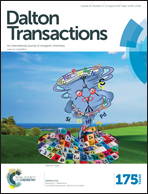Metal ion binding by pyridylethyl-containing polymers: experimental and theoretical study†
Abstract
Binding of Cu2+, Ni2+ and Ag+ ions to polyallylamine (PAA), polyethylenimine (PEI), poly(N-2-(2-pyridyl)ethylallylamine) (PEPAA), poly(N-2-(2-pyridyl)ethylethylenimine) (PEPEI), and N-2-(2-pyridyl)ethylchitosan (PEC) has been investigated using batch sorption experiments, spectrophotometric titration, ESR, and XPS to elucidate how the structure of polymer precursors affects the ion binding efficiency of their pyridylethylated derivatives. It has been shown that pyridylethylation increases the sorption capacities of PAA and PEI cross-linked with epichlorohydrin toward Ag+ and Ni2+ ions, but does not improve or decrease that toward Cu2+ ions. PEC was the most efficient material for Ag+ ion sorption with the sorption capacity of 1.21 mmol g−1. The highest sorption capacity for Ni2+ (0.62 mmol g−1) was found for PEPEI. According to density functional theory (DFT) calculations, lower Cu2+ binding efficiency to PEPEI results from the “looser” structure of this complex in comparison with unmodified PEI. DFT calculations have also suggested that the Cu2+ ion is four-coordinated in the complexes with PEPAA and PAA and five-coordinated in all other complexes, which have the structures of distorted square pyramids with Cu–N bond lengths varying significantly depending on the ligand nature. The results of the theoretical investigations of the Cu2+ complex structures were supported by the ESR data, which revealed the decrease of A‖ and the increase of g‖ values with increasing deviation from the square planar geometry of complexes in the ligands in the order PEI < PEPEI < PEPAA.


 Please wait while we load your content...
Please wait while we load your content...